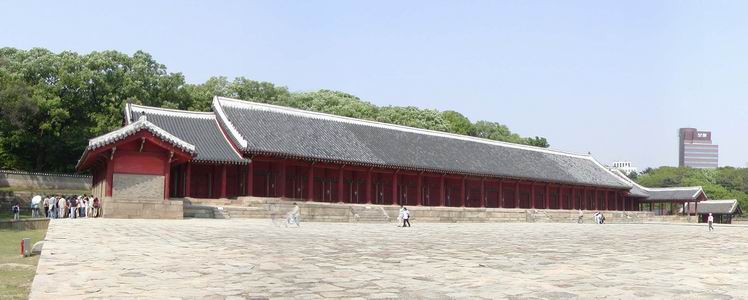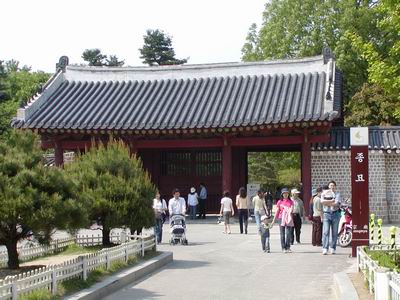Jongmyo Shrine

Jongmyo Shrine (종묘:宗廟)
Jongmyo Shrine is dedicated to the spirits of Korea's royal ancestors. The royal family of the Joseon Dynasty paid homage to their forefathers in the time-honored Confucian tradition. This sedate shrine of beautiful architectural simplicity is appreciated as an invaluable cultural inheritance and was registered on UNESCO's World Cultural Heritage List in 1995. Jongmyo Shrine is made up of Jeongjeon (정전: the main hall), Yeongnyeongjeon (영녕전: the Hall of Eternal Peace), and auxiliary facilities. Jeongjeon, with its attached cloister, is said to have been the longest building in Asia. It enshrines the memorial tablets of greatly honored kings and their queens, today containing 19 memorial tablets of kings and 30 tablets of their queens in 19 spirit chambers.
Jongmyo Jerye (종묘제례:宗廟祭禮)
Jongmyo Jerye(종묘제례), or the Royal Ancestral Rite, was one of the most important government events during the Joseon period. It was conducted five times annually. Additional rites were also performed on special state occasions to notify the ancestral spirits of the events. The king himself became an officiant who offered repetitive bows and liquor before each chamber according to strict procedures maintaining an austere ambiance. Each procedure is accompanied by ritual music, Botaepyeong and Jeongdaeeop.The orchestral ensemble is composed of Chinese-derived and native string, percussion and wind instruments including bell chimes (편종: pyeonjong), stone chimes (편경: pyeongyeong), the cylindrical Chinese oboe (당피리: dangpiri), the bowed zither (아쟁: ajaeng), and the transverse flute (대금: daegeum), which still capture the authentic form of the old court music that has been played since the early Joseon period. The head of the dynasty's Jeonju Yi Clan still officiates at the annual rite on the first Sunday of May.
Jongmyo was built in 1394, when the Joseon Dynasty moved their capital from Gaeseong to Hanyang (한양: the present Seoul), but was burnt to the ground during the Japanese invasion of Korea in 1592. The reconstruction was planned in 1604 and completed in 1608, the 1st year of Gwanghaegun (광해군: r. 1608-1623). Jongmyo Jerye, the royal ancestral rite, is certainly a historical rarity in the world, with 500-year old formalities for ancestral worship set in 1462. It keeps intact the original procedures for the offering of sacrificial gifts of food and drink in authentic ritual utensils, with royal descendents and participants costumed by rank, as well as ritual dance and music ensembles.
Jongmyo Jerye and Jongmyo Jeryeak : Masterpieces of the oral and intangible heritage of humanity
Jongmyo Jerye is a ceremony held for the king and queens of the Joseon Period in the shrine where the ancestral tablets of theirs are preserved. Jongmyo, along with the rituals where services for the Gods of Earth and Corps were performed, is considered as the important symbol which is the foundation of national survival. It has Jeongjeon(Main Hall), enshrined 49 tablets in 19 spirit chambers, and Yeongnyeongjeon(Hall of Eternal Peace), enshrined 33 tablets in 16 spirit chambers.
Jongmyo Jerye was one of the five kinds of rites performed by the Joseon Dynasty's royal family. The five were classified as gillye(auspicious rites), hyungnye(funural rites), binnye(reception ceremonies), gunne(military rites), and garye(wedding ceremonies). The gillye includes the ritual service to the gods of heaven and earth and royal ancestral spirits. Besides the rite worshiping the royal ancestors, Jongmyo Jerye has also been dedicated to meritorious civil and military retainers.
It was classified into regular and extraordinary ceremony. Regular ceremony was held on January, April, July, and October. Initially, extraordinary ceremony was held when auspicious occasions and national disasters occurred, but after the liberation from Japanese Imperialist rule, it was held at the first Sunday of May. As it was a model of all ceremonies for spirits, its order and procedures were very strict and solemn.
Jongmyo Jerye proceeded in an order of rehearsal → ancestral tablet placing → spirits welcoming → Singwanrye → food presenting → first obeisance → second obeisance → last obeisance → sacrificial food and drink partaking → Cheolbyeondu → Mangryo → closing. Before Jongmyo Jerye, a monarch was prudent in his speech and action for 4 days and cleaned his body for 3 days. 'Filial piety' is one of the Confucian tenets and Jongmyo Jerye, as the national manifestation of filial piety, took the role of enhancing the solidarity of people and bring them closer together through that very common denominator. Jongmyo Jerye, as a standard of art in Confucian society, is a valuable cultural asset and the music, dance, ritual vessels, and libation of foods of Jongmyo Jerye are essential manifestations of aesthetics of performing arts based on cosmic and Confucian principles.
Jongmyo Jeryeak, Royal Ancestral Ritual Music, had been performed when royal people held a ceremony for the repose of their ancestors in the Shrine, just named 'Jongmyoak'. Each procedure of the ceremony was composed of various music such as 'Botaepyeong' and 'Jeongdaeeop', songs called 'Jongmyoakjang' praising the civil achievements of the Joseon kings and their military exploits, and dances like 'Botaepyeong dance' and 'Jeongdaeeop dance'.
The Music was initially created in Joseon Dynasty's 4th King, Sejong's reign, for being used in royal palace banquet, and then it was modified as suitable for the ceremony under Sejo's reign, which has been handed down to the present. The music has been performed in Jongmyodaejae, which was discontinued in 1946 and was resumed in 1971, on the first Sunday of May every year.
 Jongmyo Jeryeak performed in Jongmyo Shrine consist of Botaepyeong, which has 11 music pieces, and Jeongdaeeop, which also has 11 music pieces. The musicians are divided into the upper terrace orchestra in the foreground, called the Deungga, and the lower terrace orchestra, called the Heonga. Some music pieces of Jongmyo Jeryeak had their roots in the Tang Dynasty and Song Dynasty of China, and some grew in the native environment. These three different styles of music pieces are played with different instrumental ensembles. Jongmyo Jeryeak performed in Jongmyo Shrine consist of Botaepyeong, which has 11 music pieces, and Jeongdaeeop, which also has 11 music pieces. The musicians are divided into the upper terrace orchestra in the foreground, called the Deungga, and the lower terrace orchestra, called the Heonga. Some music pieces of Jongmyo Jeryeak had their roots in the Tang Dynasty and Song Dynasty of China, and some grew in the native environment. These three different styles of music pieces are played with different instrumental ensembles.
Line dances are performed to the orchestral accompaniment of Deungga or Heonga in accordance with ritual procedures. Line dances aim at delineating the harmony of the negative and positive cosmic forces of yin and yang while they shifts between civil dance(Munmu), delineating the positive force of yang to praise the civil achievements of the Joseon kings, and military dance(Mumu), delineating the nature of negative force of yin to praise the military achievements of the Joseon kings, for which the hand-held props are changed appropriately.
Hundreds of officiants, musicians, dancers, and attendants all create the tout ensemble of this composite art reflecting solemnity and magnificence typical in Oriental world. That this original property has continued without impairment for 500 years makes it indeed rare in the world, so that its value should be preserved as part of the world's intangible cultural heritage and its benefits should be shared with a broad range of people worldwide.
Jongmyo Jeryeak, Important Intangible Cultural Properties No. 1, was selected as 'Masterpieces of the Oral and Intangible Heritage of Humanity', with Jongmyo Jerye, Important Intangible Cultural Properties No. 56
Enterance of Jongmyo Shrine ※ Jongmyo Shrine Official Site
- Open from 9 a.m to 5 p.m every day (except every Tuesday)
- Access : Take the Seoul subway line number 3 (orange line) or (purple line). Then get off at the Jongro 3 ga station(종로3가역) . Gate number is 11. (2009.2)
|